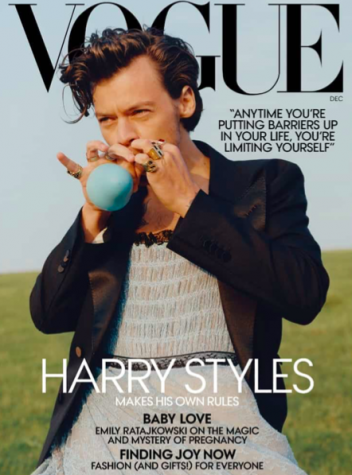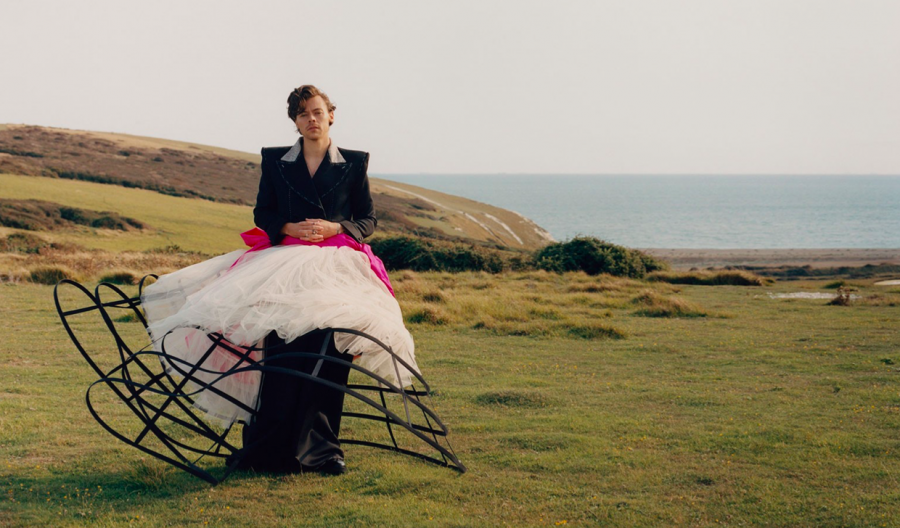In Defense of Harry Styles
Harry Styles was the first man to appear on the cover of Vogue Magazine.
November 23, 2020

Vogue Magazine and British singer-songwriter Harry Styles made history Nov. 13 when he became the first-ever male cover star of the magazine. The cover beautifully challenges gender stereotypes, as Styles is dressed in a periwinkle blue dress paired with a black blazer.
“When you take away ‘there’s clothes for men and there’s clothes for women,’ once you remove any barriers, obviously you open up the arena in which you can play,” Styles told Vogue. “Anytime you’re putting barriers up in your own life, you’re just limiting yourself. There’s so much joy to be had in playing with clothes.”
Immediately upon its release, controversy sparked media-wide, especially among prominent conservatives. Many voiced their disapproval of Styles’ clothing.
“Bring back manly men,” wrote right-wing media commentator Candace Owens via tweet, ignorantly suggesting that Styles dressing in more feminine clothing somehow makes him less of a man.
Fellow conservative media commentator Ben Shapiro agrees with the claims made by Owens.
“Anyone who pretends that it is not a referendum on masculinity for men to don floofy dresses is treating you as a full-on idiot,” wrote Shapiro.
Actor Elijah Wood offered a perfect response to Owens and Shapiro. “I think you’ve missed the definition of what a man is,” Wood posted on Twitter. “Masculinity alone does not make a man, in fact, it’s got nothing to do with it.”
Yes, Harry Styles wore a dress. So what? Men don’t owe you masculinity.
Let alone, challenging gender norms through clothing is not new to men in the music industry. Music icons including Prince and David Bowie embraced femininity and androgynous fashion.
Still, Owens continued to express her criticism on an Instagram live stream.
“There is no society that can survive without strong men,” she said. To her, feminine clothing on men is an indication of frailty. “You have a whole lot of human history for you to look at. The role of men is to defend, it’s the role to protect.”
Okay then, let’s look at human history.
Dating all the way back to the age of hunters and gatherers, societies actually functioned with fluid gender roles. Many consider the hunting aspect to be a male-biased role, however, based on a 2020 study led by Randall Haas, an archaeologist and assistant professor of anthropology at UC Davis, the hunter-gatherer societies among the Late Pleistocene/Early Holocene populations were most likely gender-neutral.
Later on, as the distinction between genders became more prominent, both males and females were favored to participate in big-game hunting. Not every male was a hunter, some were gatherers, and vice versa for females.
So, contrary to Owens’ claims, societies can function in ways that she may not view as “traditional.” Certain roles of men and women may sometimes differ, but men should not be confined to one while women are confined to another.
Prohibiting men from expressing themselves through clothing because you view it as “not normal” and less “manly” fuels the toxic masculinity that is already abundant in our society today.
A person’s strength is not defined by what they wear.

If men are expected to be courageous, how does authentic self-expression make him less of a man? How does a man being comfortable in his own skin make him weak?
Feminine clothing on men is not an “attack” on anything, despite what some conservative commentators claim. In no way should it be viewed as a “threat to society” or a ploy for leftists to “push an agenda.” Men dressed in feminine clothing are not a result of “toxic females” and “fake feminism.”
Men dressed in feminine clothing are simply men wanting to embrace themselves through their style.
“I’ll put on something that feels really flamboyant, and I don’t feel crazy wearing it,” said Styles. “I think if you get something that you feel amazing in, it’s like a superhero outfit. Clothes are there to have fun with and experiment with and play with.”








Soy Boy Beta Male • Dec 12, 2020 at 4:42 am
I would recommend everyone criticizing Harry Styles for wearing a dress to reflect on how you perceive your own masculinity. Other men can wear dresses and you can still maintain your masculine identity. This isn’t a symbol of the collapse of “Western” society and patriotism. As others have pointed out, gender fluidity has existed throughout history in Western and non-Western societies. The VAST majority of people that experiment with gender do so well after childhood. Harry Styles wearing a dress is not corrupting the youth. He can wear a dress if he wants to. This choice of dress should fall in line with the patriotic value of freedom. Expression through clothing legally falls under freedom of speech. To criticize someone or tell someone they cannot wear something is to strip them of their constitutional right to freedom of speech. Also, many of you mentioning gender theory should actually read some. It might give you a more informed opinion on the historical, social, and cultural dynamics of gender.
Sylvia • Dec 11, 2020 at 8:28 pm
Dear concerned patriot,
You said that you’re “100% sure” that females don’t find Harry Styles attractive? Obviously you haven’t been aware of the numerous people in our school and around the world that are attracted to him. I am in fact one of those people. Maybe get your numbers right next time please? Thanks! XOXO
Time = Money • Dec 10, 2020 at 11:34 am
I would like to state on record that the email that started this particular email chain, and the only email here I’ve ever sent, contained no profanity in the three pillars of word choice, subject (which was not explicit), and context. The above email chain’s evolution took its course through the inappropriacy of others to not recognize that the explicit content that they (they being in reference to the individuals who replied with profanity) made the decision to include must be censored from even the consideration of sending out to a school organization. I simply made the offer that I would be open to letting my valued time be spent through financial compensation. I’m doing what was shown (as a teacher) you do when you have a product. I have one…and it’s in demand 3 times a week every week for 9 months. Respectfully speaking.
Clinically Insane Gender-bender • Dec 7, 2020 at 11:06 am
Dearest concerned patriots,
I really do hate to burst your concerned and patriotic bubble, but men wearing dresses and heels is no new phenomenon originating from the “gender-obsessed” twenty-first century. Men have been wearing what we would now classify as a dress for centuries– take a look at Henry VIII for example. Examine the history of the traditionally feminine and glamorous heels– originally worn by… men? When women first began wearing heels as a fashion item, men even complained about them stealing their items of fashion! The claim that breaking gender roles through dressing yourself is simply absurd. Did the Roman Empire fall because the senators were wearing glorified dresses? Did the Visigoths take a look at the toga praetexta and tunic and decide that was the final straw– they were going to conquer the west? I don’t think so.
On the topic of your children, I sincerely hope that they can break free from your close-minded parenting skills someday and feel safe enough to explore their identity through fashion if they so wish.
I will not argue with you. I am not trying to change your mind. I am simply refuting your poor straw-man riddled argument with facts of my own. I suggest gathering some of your own for future instances in which you want to attack scientific and historic research. Thank you, and do get well soon. <3
A very wise man • Dec 7, 2020 at 9:37 am
Im glad that you comfort and wisdom in my quote will. In decisive times like these, it is important that we all remember to live laugh and love.
Will • Dec 4, 2020 at 10:26 pm
“Don’t yuck someone else’s yum” -A Very Wise Man
Jason • Dec 4, 2020 at 2:48 pm
Hello Mr. and Mrs. Concerned Patriot,
Thank you for expressing your opinions in this comment section. I’m beginning to question your patriotism, considering that you idolize such ‘freedom-loving nations’ as Saudi Arabia and China, and that you want to restrict our personal freedoms because you equate ‘gender bending fashion’ with the downfall of Western Civilization.
As a male, I genuinely do not care about the fashion choices of Harry Styles. The only person whose fashion I care about is me. Will I go out and wear a dress anytime soon? No, and I know you won’t either. Please keep your golf shirts and khaki pants to yourself, and let others live their lives.
Furthermore, it’s also important to point out that men do many different things, none of which make them any less of a man. I like watching football and playing video games; Harry Styles likes to sing and (sometimes) wear dresses. The common thing here is that we are both MEN. And, according these comments, some women are attracted to men who sing and wear dresses, and that’s okay.
A wise man once said “Treat people with kindness.” Why don’t you grow up and do that yourself.
Peace.
Nina Stepaniants • Dec 4, 2020 at 2:04 pm
Dear Extremely Concerned Patriot,
I really hate to break this news to you, but I’m going to have to ask you to look up “traditional Saudi Arabian men’s clothing” and go to google images. I’m sorry for any distress this may cause.
Extremely Concerned Celt • Dec 4, 2020 at 1:06 pm
I really do not want to insult this “patriot”‘s intelligence, but there seems to be a blatant misunderstanding of the definitions of masculinity vs feminity, as it has been continuously evolving since the dawn of time. Firstly, the men of ancient Rome and Greece (the blueprint of western society), were known to sport drapes and tunics. additionally, the kilt, traditionally worn by men from the Scottish Highlands, represents strength and loyalty to one’s clan. It has also become a staple of western attire as it has spread through the Celtic diaspora. Fast forward to Elizabethan England or even 18th Century France, and you will see that makeup was extremely popular among men of high status. These examples only pertain to western culture and don’t even begin to scratch the surface of clothing and gender roles in other parts of the world. I highly suggest that these readers who feel that people like Harry Styles are tearing at the fabric of our society pick up a history book every once in a while.
Harry Styles • Dec 4, 2020 at 12:32 pm
Hey guys to everyone who is dissing me for wearing a dress……dont knock it till ya try it 🙂 Have a nice day
Will Elliott • Dec 4, 2020 at 12:05 pm
Hey “Fellow Concerned Patriot!”
Not sure why everyone who disagrees with this opinion piece feels the need to conceal their identities. Interesting slippery slope fallacy, though! I haven’t seen any good stand-up specials recently, so thanks for the laugh. A dude wearing a dress will lead to the downfall of society?! Uh…okay…whatever you say. No one who disagrees with this article is actually trying to address its argument, they’re just repeating the same old “naturalistic” talking points. Human society created gender stereotypes, so humans can break them.
What a succinct & eloquent piece, Anna! Always some great conversation in the Forest Scout opinion section!
Anyway, I have a test to study for on the kilt-wearing Celts and toga-wearing Romans, so I’ll get to it.
Signed,
Will
Fellow Concerned Patriot • Dec 4, 2020 at 11:09 am
I am a woman and in no way do I find Harry Styles attractive. Neither do you girls, who virtue signal your “attraction.” Any girl would take a masculine man over a feminine one had they the same qualities; it’s the basic laws of attraction. Not everyone finds Harry Styles and men like him attractive, which is partly why I wrote this comment, to defend the ones who don’t and who agree with myself and the other “Patriot”-like people out there. While you may “disagree” with and attack my comment, it’s true. This needs to be heard and people need to realize the bizarre world we are living is leading to our society’s inevitable downfall. The article was well written, but I strongly disagree with it’s message. Research for yourself before following the herd and please actually consider what I have to say before rebutting it.
Haley Zarek • Dec 4, 2020 at 11:04 am
Thank for for writing such an amazing piece Anna.
It is okay for others to feel comfortable in clothing you perhaps wouldn’t want to wear. This effects you in no capacity. No one is forcing you to wear something you are not comfortable in. Seriously. You shouldn’t care what other people wear-let’s treat people with kindness!!!
Eva Sharman • Dec 3, 2020 at 4:45 pm
Thank you Anna for writing an excellent article!!!!
I am so thankful that our generation has role models such as Harry Styles.
It’s fascinating to me that people such as Ben Shapiro, Candace Owens, and the above commenter are so incredibly bothered by someone else’s choice of clothing that they decide to make such a fuss about it. If anything, this is only bringing more mainstream media coverage to new and beautiful forms of self expression, and inspiring more people to fight for the right to be themselves. I look forward to a new and inevitable future in which people won’t be judged for what they wear or how they identify, and will instead be judged by how they treat others.
P.S. Dearest “extremely concerned,” you sound threatened. I can 100% tell you that women are not attracted to arrogant, exclusionary, and traditionalist males. Don’t worry, us women can do better ?
LFHS Student • Dec 3, 2020 at 3:52 pm
Hi Extremely Concerned Patriot!
50 years ago, they were saying the same thing about women who wore pants, which were traditionally masculine at the time. Would you consider Mary Tyler Moore, one of the first women to wear pants on public television, to be less of a woman? Did she singlehandedly cause the decline of Western civilization, like you claim Harry Styles is doing by wearing traditionally feminine clothing? Or are you just using outdated gender roles to justify your bigotry….
Just something to think about 🙂
the Thin White Duke • Dec 3, 2020 at 11:06 am
Prince and David Bowie “embraced femininity” as a publicity stunt. If you want to mention things David Bowie has said or done, be careful because he also said Britain needs a fascist leader and what not. Lots of cocaine influenced that, which is not influencing Harry Styles. Harry Styles is legit about this, that is what is different and kinda cringe tbh. Musicians often come up with gimmicks to set themselves apart from competing bands. Look at Black Sabbath or just use your head.
Yana Savitsky • Dec 2, 2020 at 4:50 pm
First off, I would like to second the lovely ladies who have already commented — I find Harry Styles incredibly attractive as a woman. And, to my knowledge, I am not clinically insane (according to my psychiatrist and faith leader). Secondly, men don’t owe you masculinity. Women don’t owe you feminity. People don’t owe you anything. I think everyone just wants to feel confident in what they wear and how they appear. If that means wearing a dress, so be it. “Extremely Concerned Patriot”, it’s not directly harming you — you’re harming yourself. You’re getting preoccupied with the self-expression of another person. Clearly, even you know this is overkill by keeping anonymity. Get a new hobby or something. In the meantime, society won’t burn down just because a man wore a dress — trust me.
In conclusion, I’d recommend knitting. Or, is that too feminine for you?
P.S. I’m concerned for your children. I hope you grow to love them unconditionally, no matter how they choose to express themselves.
Anna, I love the article.
katie hart • Dec 1, 2020 at 7:41 pm
Hey “patriot” I feel extremely sorry for your future children that won’t feel comfortable expressing themselves to you! I don’t think your children would be at all confused about their gender, but instead open to finding themselves and feeling comfortable enough to be who they are (obviously not with you as a parent though, as you stated yourself). Hate does no good and obviously we are moving in a direction where there is no judgement. Instead of fighting that, join us 🙂 Also I think if you were really proud of that opinion of yours, you’d probably put your name. And, I actually find Harry Styles to be one VERY attractive and “masculine” male, not because of what he wears, but his confidence (I wish that I could rock a dress like him). Also, “shame on you” are you joking? Shame on you.
Also Anna, I thoroughly enjoyed reading your article!! We have a very similar stance on this truly historic moment.
Navya Kunadi • Nov 24, 2020 at 9:31 pm
I loved reading this. Clothing has no gender!
Kailey Albus • Nov 24, 2020 at 7:54 pm
Hey there, Extremely Concerned Patriot.
Just wanted to let you know that I am a woman, and I find Harry Styles incredibly attractive — even as a “femboy soyboy beta male”. Maybe consider lowering your percentage on that, and if the idea of a boy in a dress ruining our society scares you this much, maybe you should consider talking to a psychiatrist or youth leader as well. Just looking out for you 🙂
Great article, Anna!
Extremely Concerned Patriot • Nov 24, 2020 at 6:17 pm
Please do not ban my comment, I have something important to say: This is absolutely disgusting and shame on you for expressing these opinions. The single most prominent sign of a society on the brink of collapse is the onslaught of what we’d call “gender-bending” fashions and lifestyles. Harry Styles is proving that he is part of this massive problem. Calling him a man at this point is no more than a joke. ““Bring back manly men,” wrote right-wing media commentator Candace Owens via tweet, ignorantly suggesting that Styles dressing in more feminine clothing somehow makes him less of a man.” How is it ignorant to suggest that dressing in clothes that are and have been for hundreds of years “men’s clothes” should be worn by men to express their masculinity? I can 100% tell you that women are not attracted to these sort of femboy soyboy beta males. Lets be real here, this is not attractive in any way. This is bizarre. This is scary. This concerns me, I do not want my children to grow up in a world where they’ll be confused about their gender. We have seen that shoving the gender-spectrum and modern gender theory narrative down the throats of impressionable youths has been a complete and utter disaster. You are partially responsible for the destruction of the magnificent society our forefathers HAD built, which is now actively being destroyed by these monsters. “Yes, Harry Styles wore a dress. So what? Men don’t owe you masculinity.” Yes, yes they do. Without masculine men and feminine women we don’t have a society. We don’t have children. We don’t have the nuclear family. That is when society breaks down. Does China or Saudi Arabia have this problem with gender confusion? No, and they are laughing at the West, and will take us over. This little garbage UC Davis pseudoscientific study is completely wrong. There are gender roles. Men and women are DIFFERENT. Gender is NOT fluid. THERE ARE 2 GENDERS. If you make any other assertion, you are clinically insane and I strongly recommend you see a psychiatrist or some sort of faith leader. Your ancestors for hundreds and hundreds of years would all laugh at you and be ashamed of the gender confusion nonsense. This is all so experimental. Harry Styles and people like him are actively destroying Western Civilization, and this is no civilization to experiment modern gender theory on. Wake up. This is real, this is no longer a meme. These degenerates want to destroy the very fabric of our society, and I think that is quite disgusting. May God protect the family and stop this madness.